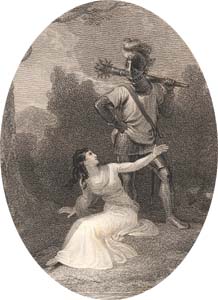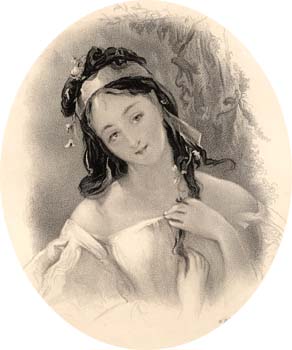|
|
Home | Corson Collection | Biography | Works | Image Collection | Recent Publications | Portraits | Correspondence | Forthcoming Events | Links | E-Texts | Contact Harold the DauntlessFirst Edition, First Impression: Harold the Dauntless: A Poem, in Six Cantos. By the Author of "The Bridal of Triermain". Edinburgh: Printed by James Ballantyne and Co. For Longman, Hurst, Rees, Orme, and Brown, London; and Archibald Constable and Co. Edinburgh. 1817. Composition | Synopsis | Reception | Links Composition
SynopsisThe poem's hero Harold, son of the Norse King Witikind, is appalled when his dying father receives Christian Baptism in exchange for a grant of Church lands. In protest at the betrayal of Viking ideals, he quits home. On his travels he meets and woos Princess Metelill who is already betrothed to the English Lord William. The girl's father is virulently opposed to his suit, considering Harold a barbarous Pagan. Meanwhile, the Church authorities plot to have Harold disinherited. He reacts violently but is persuaded to undertake a knightly quest, during which he encounters Witikind's ghost who tells him that he is condemned to wander restlessly until his son repents. Chancing upon Metelill's wedding procession, Harold kills her father and is barely prevented from killing the groom by own his servant, Gunnarr. Having reached the destination of his quest-journey, a castle, he finds himself plunged into the region of the dead where preparations are being made for his own arrival. He confronts and destroys the Odinic spirit which rules over the region and rescues Gunnarr from Óðinn. Gunnarr turns out to be the Danish maiden Eivir in disguise. Harold announces his intentions to receive baptism and to marry Eivir, and his father's troubled spirit is able to rest in peace.
ReceptionFew critics penetrated the mystery of the poem's authorship, most regarding it as a second-rate imitation of Scott himself. Blackwood's considered it 'an elegant, sprightly and delightful little poem' but 'generally inferior to the works of Mr Scott, in vigour and interest'. For the Literary Gazette, it possessed a 'caricature resemblance' to Scott's verse, while the Monthly Review lamented 'faults engendered by a servile imitation of Mr Scott's bad grammar and discordant versification'. Such comments, combined with indifferent sales, did nothing to dissuade Scott from the opinion that his future lay with prose fiction. LinksLast updated: 19-Dec-2011
|
|

 Scott
began work on Harold the Dauntless, his last long verse
narrative, in October 1815, shortly after completing
Scott
began work on Harold the Dauntless, his last long verse
narrative, in October 1815, shortly after completing 